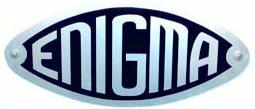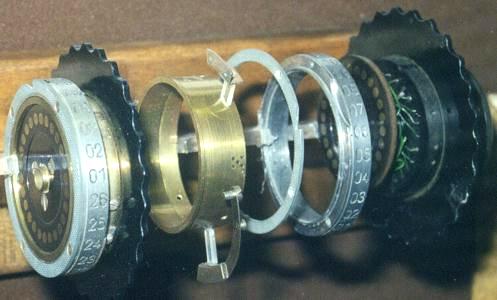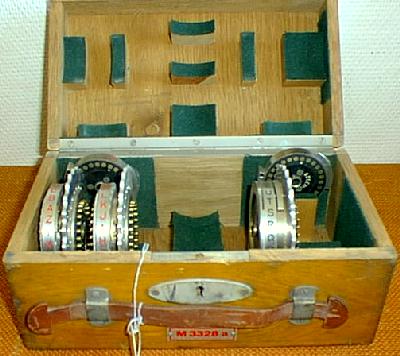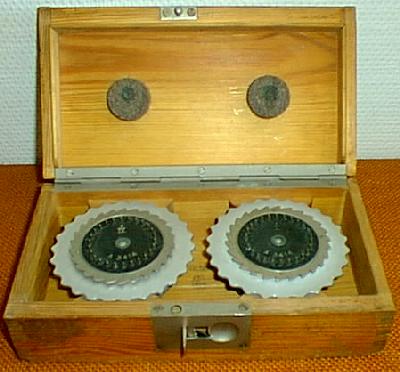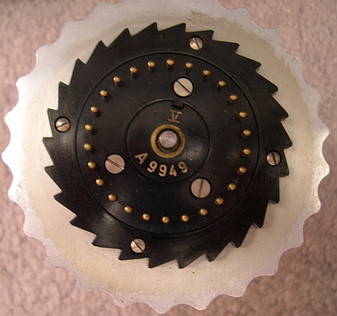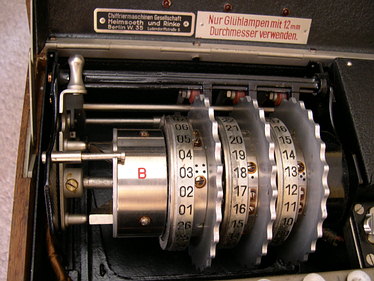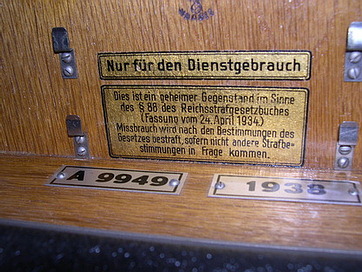The Enigma was one of the best of
the new electromechanical cipher machines produced for the commercial market
in the 1920s. Hugo Koch, a Dutchman, conceived of the machine in 1919.
Arthur Scherbius first produced it commercially in 1923. Impressed by its
security, which was based on statistical analysis, the German government
acquired all rights to the machine and adapted it to the needs of its new,
modern military forces. It became the standard cipher machine of the military
services, of German agents, and of the secret police. It was also used
at all echelons from high command to front-line tactical units including
individual airplanes, tanks, and ships. An ordinary three-wheel Enigma
with reflector and six plug connections generated the following number
of theoretical coding combinations:
3,283,883,513,796,974,198,700,882,069,882,752,878,379,955,261,095,623,685,444,055,315,226,006,
433,616,627,409,666,933,182,371,154,802,769,920,000,
000,000
That is roughly the same as 3.283 x 10114 .
Given this statistical capability, proper communications
procedures and practices, and the fact that solving the Enigma on a timely
basis would require rapid analytic machinery which did not exist, the Germans
regarded the Enigma as impenetrable even if captured. The Germans, however,
did not always practice proper communications security, and, more importantly,
the Allies, even in 1938-39, were on the verge of creating the necessary
cryptanalytic machinery which would unlock the Enigma's secrets. The evolution
of this technology and its application were major contributing factors
to the ultimate Allied victory in World War II.
 |
| Nigel West, an leading author specializing
in security and intelligence issues, is also an Enigma collector and has
this Wehrmacht three rotor Enigma in his collection. He would be
pleased to supply other Enigma photographs to anyone who needs them.
E-mail: nigel(at)westintel.co.uk
(Photo courtesy of Craig Longhurst) |
 |
| Here is a fine example of a pre-WWII built Luftwaffe Enigma
machine (serial A6345 dated 1937) with the added benefit of three high-quality,
matched, rotors and the Umkehrwalze D option. The German designation is
Chiffriermaschine Gesellschaft and it was made by Heimsoeth
und Rinke of Berlin. (Photo courtesy John Alexander, G7GCK Leicester,
England. |
The machine above carries serial number A6345 with matching serial
numbers on all the rotors. Option Umkehrwalze (UKW) D is the unusual and
rare part. Germany began to introduce the UKW D to make the Enigma even
more complex and secure in 1944. A full description of the UKW D, by Philip
Marks, can be found in CRYPTOLOGIA Vol XXV # 2 (Apr ‘01), Vol XXV
# 3 (Jul ‘01) and Vol XXV # 4 (Oct ‘01) .
The importance of this UKW type is that it is re-wireable. Removing
the outer case (a tight fit) reveals moveable plugs and their sockets.
The UKW was introduced to the Luftwaffe and caused Bletchley Park some
concern. There is a special Enigma at BP even now - one specifically
modified to tackle UKW D. Fortunately, German operators in the field did
not like the hassle involved in using this additional part so its use never
became popular. See Museum Info section)
Enigma/NEMA type light bulbs (3.5v) can be found with
250, 300, 350 and 400 mA ratings. Most seem to be 300 or 350 mA.
 |
| A three rotor pre-war Enigma machine in operation.
The man using the machine is a Waffen-SS NCO. An Enigma weighs around 30
pounds without the carrying case and 35 pounds with carrying case. (Photo
courtesy of Synder's Treasures, Bowie, Maryland). |
 |
| This is no ordinary Enigma - this one's special
because it is out in the open at the National Cryptologic Museum. Visitors
can actually cipher and decipher messages and watch the machine in operation.
A sign below the unit says "Please Be Gentle". (Photo by Jerry Proc) |
